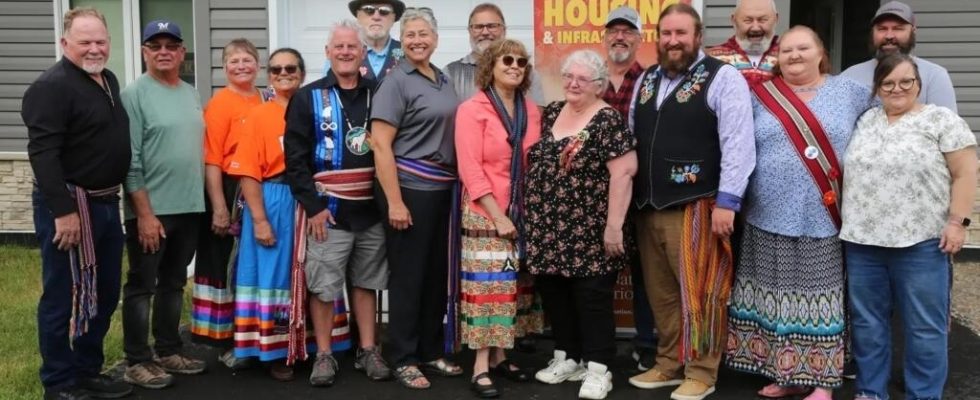Made up of territories and federated provinces, Canada is also populated by First Nations and Inuit, but not only. The Métis have formed nations in some provinces. The Métis Nation of Ontario, whose legitimacy sparks debate among the Métis themselves and is rejected by other Aboriginal peoples, could be the first to see their right to self-governance recognized by the federal government.
5 mins
From our correspondent in Montreal,
Mitch Case, full red beard and mischievous almond eyes, is a Métis craftsman. On his Facebook page and on his website, he shares his passion for beadwork: he practices a traditional style of Métis floral beadwork, covering his clothes with traditional patterns. Far from being limited to art, the 30-year-old is also invested in the Métis Nation of Ontario, of which he is one of the regional advisers: in Canada, the Métis are not simply an ethnic mixture, but a real culture. at the crossroads of First Nations and settler ancestors.
At the start of the year, the federal government announced that it wanted to table a bill to enshrine in the Canadian Constitution the principle of self-governance of the Métis Nation of Ontario, which recognizes its community’s powers in terms of administration and citizenship. “ It would consolidate rights that we have fought for for years », enthuses Mitch. The project could be tabled within the year, but protests are rising on the side of the First Nations and even among certain Métis communities.
A community in a patchwork
Canadian society was and still is a federal political project, originally imposed by English settlers, who tried to hold together a patchwork of different peoples. For example, the Inuit and the First Nations, such as the Crees or the Atikamekw, were there before the arrival of the settlers : they obtained political rights and powers over their communities. Some Quebecers are still fighting for independence, by virtue of their French-speaking origins.
” The Métis originally emerged in the Red River region in the early 19th century, when French Canadians working for the North West Company and Scots employed by the Hudson’s Bay Company are mixed with Aboriginal people, such as the Crees says Francis Lévesque, anthropologist professor at the School of Indigenous Studies at the University of Quebec in Abitibi-Témiscamingue. The fur traders then worked in close relationship with the First Nations: unlike what may have existed in other territories, they did not blend into the Aboriginal culture, but created a hybrid culture.
The Métis were already included in the rights that the First Nations had obtained, in particular the article of the constitutional law of 1982 which recognizes “ existing rights – aboriginal or treaty – of the Indigenous peoples of Canada,” such as the right to hunt. However, there was no definition of the term “Métis”. Who was Metis? In 1993, Steve and Roddy Powley, Métis, were charged with hunting the moose without a permit. Ontario is suing them, but they plead not guilty under this section. The Canadian Supreme Court will give them reason ten years later, opening the door to recognition of Métis rights and establishing the Powley test to determine whether or not a person is from the Métis culture.
Internal and external tensions
Despite progress, the aspirations of the Métis Nation of Ontario are not unanimous. Historically, the Metis are mostly concentrated in Manitoba, another province of Canada. However, since the Supreme Court’s decision, a large number of Canadians have defined themselves as Métis using the Powley test. ” Those who are called the historic Métis of Red River have several organizations: some of them will recognize the movements of the Métis in Quebec and Ontario, others, the most important, do not recognize them. Many Métis leaders say the majority are individuals who take ownership of their identity observes Francis Lévesque. The Métis Nation of Ontario voted in March the exclusion of 18% of its members who had lied about their ancestry to obtain fishing and hunting rights in particular.
For Mitch Case, the question does not arise: he is Métis, and always has been, and his family raised him as such. Its culture is a mixture of historical events, such as the battles of the Métis against the federal project in the 19th century, crafts, dialects and a particular worldview. “ Historically, our communities had what is now called a syncretic worldview, where they did not see their traditional indigenous spirituality and Christianity as opposing each other, but as complementary. “, explains the regional councilor. Similarly, even though he does not speak the Métis dialect of his community, his ancestors speak and speak a mixture of French and Indigenous languages.
First Nations peoples also take a dim view of the emergence of Métis claims, which risk encroaching on their territories in particular. Some communities even declare that no Metis lived on some of their territories, in memory of the elders. For Métis Nation of Ontario legal counsel, Jason Madden, interviewed by Radio Canadathe question does not arise: the future agreement with the federal government will have no impact on the agreements concluded with the other First Nations.
Far from limiting itself to these legal and political debates, the Métis Nation of Ontario is now trying to strengthen ties in its community: it is building affordable housing and supporting workers. This is the most important, considers Mitch Case: In addition to our day-to-day political responsibilities, we are also building Ontario’s first cultural center dedicated to the Métis Nation. It will be a museum, a home for our stories, to come together, to celebrate and to mourn our dead. » The Métis of Ontario thinks this center will open in the fall, hoping that it will shortly precede the passage of the bill aimed at strengthening the rights of its community.
